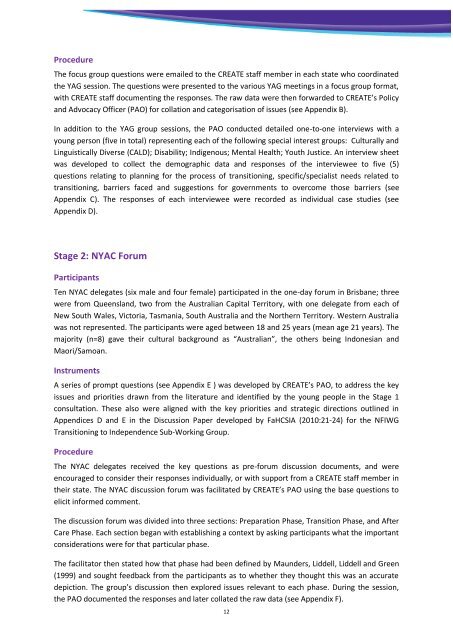What's the Answer? - Create
What's the Answer? - Create
What's the Answer? - Create
Create successful ePaper yourself
Turn your PDF publications into a flip-book with our unique Google optimized e-Paper software.
ProcedureThe focus group questions were emailed to <strong>the</strong> CREATE staff member in each state who coordinated<strong>the</strong> YAG session. The questions were presented to <strong>the</strong> various YAG meetings in a focus group format,with CREATE staff documenting <strong>the</strong> responses. The raw data were <strong>the</strong>n forwarded to CREATE’s Policyand Advocacy Officer (PAO) for collation and categorisation of issues (see Appendix B).In addition to <strong>the</strong> YAG group sessions, <strong>the</strong> PAO conducted detailed one-to-one interviews with ayoung person (five in total) representing each of <strong>the</strong> following special interest groups: Culturally andLinguistically Diverse (CALD); Disability; Indigenous; Mental Health; Youth Justice. An interview sheetwas developed to collect <strong>the</strong> demographic data and responses of <strong>the</strong> interviewee to five (5)questions relating to planning for <strong>the</strong> process of transitioning, specific/specialist needs related totransitioning, barriers faced and suggestions for governments to overcome those barriers (seeAppendix C). The responses of each interviewee were recorded as individual case studies (seeAppendix D).Stage 2: NYAC ForumParticipantsTen NYAC delegates (six male and four female) participated in <strong>the</strong> one-day forum in Brisbane; threewere from Queensland, two from <strong>the</strong> Australian Capital Territory, with one delegate from each ofNew South Wales, Victoria, Tasmania, South Australia and <strong>the</strong> Nor<strong>the</strong>rn Territory. Western Australiawas not represented. The participants were aged between 18 and 25 years (mean age 21 years). Themajority (n=8) gave <strong>the</strong>ir cultural background as “Australian”, <strong>the</strong> o<strong>the</strong>rs being Indonesian andMaori/Samoan.InstrumentsA series of prompt questions (see Appendix E ) was developed by CREATE’s PAO, to address <strong>the</strong> keyissues and priorities drawn from <strong>the</strong> literature and identified by <strong>the</strong> young people in <strong>the</strong> Stage 1consultation. These also were aligned with <strong>the</strong> key priorities and strategic directions outlined inAppendices D and E in <strong>the</strong> Discussion Paper developed by FaHCSIA (2010:21-24) for <strong>the</strong> NFIWGTransitioning to Independence Sub-Working Group.ProcedureThe NYAC delegates received <strong>the</strong> key questions as pre-forum discussion documents, and wereencouraged to consider <strong>the</strong>ir responses individually, or with support from a CREATE staff member in<strong>the</strong>ir state. The NYAC discussion forum was facilitated by CREATE’s PAO using <strong>the</strong> base questions toelicit informed comment.The discussion forum was divided into three sections: Preparation Phase, Transition Phase, and AfterCare Phase. Each section began with establishing a context by asking participants what <strong>the</strong> importantconsiderations were for that particular phase.The facilitator <strong>the</strong>n stated how that phase had been defined by Maunders, Liddell, Liddell and Green(1999) and sought feedback from <strong>the</strong> participants as to whe<strong>the</strong>r <strong>the</strong>y thought this was an accuratedepiction. The group’s discussion <strong>the</strong>n explored issues relevant to each phase. During <strong>the</strong> session,<strong>the</strong> PAO documented <strong>the</strong> responses and later collated <strong>the</strong> raw data (see Appendix F).12




![pdf [107kB] - Department of Families, Housing, Community Services](https://img.yumpu.com/51272499/1/190x245/pdf-107kb-department-of-families-housing-community-services.jpg?quality=85)










![Land Claim - pdf [278kB] - Department of Families, Housing ...](https://img.yumpu.com/47002639/1/184x260/land-claim-pdf-278kb-department-of-families-housing-.jpg?quality=85)

![Borroloola Land Claim - pdf [299kB] - Department of Families ...](https://img.yumpu.com/46103973/1/184x260/borroloola-land-claim-pdf-299kb-department-of-families-.jpg?quality=85)